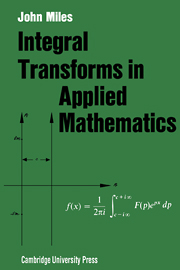Summary
The following treatment of integral transforms in applied mathematics is directed primarily toward senior and graduate students in engineering and applied science. It assumes a basic knowledge of complex variables and contour integration, gamma and Bessel functions, partial differential equations, and continuum mechanics. Examples and exercises are drawn from the fields of electric circuits, mechanical vibration and wave motion, heat conduction, and fluid mechanics. It is not essential that the student have a detailed familiarity with all of these fields, but knowledge of at least some of them is important for motivation (terms that may be unfamiliar to the student are listed in the Glossary, p. 89). The unstarred exercises, including those posed parenthetically in the text, form an integral part of the treatment; the starred exercises and sections are rather more difficult than those that are unstarred.
I have found that all of the material, plus supplementary material on asymptotic methods, can be covered in a single quarter by first-year graduate students (the minimum preparation of these students includes the equivalent of one-quarter courses on each of complex variables and partial differential equations); a semester allows either a separate treatment of contour integration or a more thorough treatment of asymptotic methods. The material in Chapter 4 and Sections 5.5 through 5.7 could be omitted in an undergraduate course for students with an inadequate knowledge of Bessel functions.
The exercises and, with a few exceptions, the examples require only those transform pairs listed in the Tables in Appendix 2.
- Type
- Chapter
- Information
- Integral Transforms in Applied Mathematics , pp. v - viPublisher: Cambridge University PressPrint publication year: 1971

